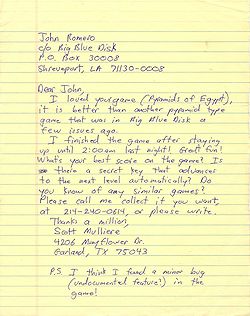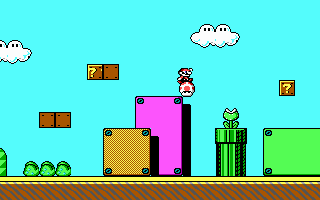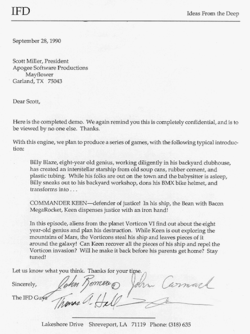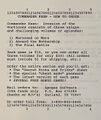Keen: Vorticons Development
This page is intended to have information regarding events that led to the development of the Invasion of the Vorticons trilogy and some interesting insights into what happened during the development.
The birth of id Software
Forming of Gamer's Edge
Tom Hall arrived at Softdisk in September 1987, having a degree in computer science from the University of Wisconsin at Madison. Despite disliking Shreveport, he felt the job was good enough to keep him at bay, developing five to ten programs each month which were then released on a monthly disk. One of the titles Tom Hall developed was called Duck Boop.
Other aspiring developers were also getting attracted to Softdisk, John Romero being one of them. In March of 1989, he joined Softdisk with his programming experience mainly involving porting Apple games for the Commodore 64 and vice versa. He became friends with Tom Hall and soon also started the Gamer's Edge game disk, which was a monthly publication focusing on games only.
One of the later titles published through Gamer's Edge during these early years included the relatively successful Pyramids of Egypt, which also caught Scott Miller's attention. With Scott still waiting for the blockbuster title to get his company off the ground, he was looking for aspiring developers who would develop shareware titles for his company (Apogee Software) and saw John Romero as a very potential candidate. Scott Miller wrote a handful of "fan letters" posing as different fans to John Romero in the hopes that he would write back to him, using different excuses like finding a bug, or "Please write back! I'm 65 years old". He did this because Scott thought Softdisk was screening letters to prevent poaching. Despite this, Romero firstly just put them up on his wall until he would later notice something common about them all...
The arrival of the Carmack
John Carmack, working at a pizza shop in Kansas City and programming in his free time had started noticing the Gamer's Edge publications and became interested in joining the project. He sent some programs he had developed to Softdisk and they impressed them enough for him to get a job and soon he too was traveling to Shreveport.
It did not take long before John Carmack and John Romero teamed up, and Tom Hall also snuck in during nights to join in as the management at Softdisk did not allow their employees to collaborate.
The major breakthrough
Late one night on September 19th, 1990, when John Carmack and Tom Hall were working on a new EGA engine for a side-scrolling game Carmack finally accomplished what he had been working on for quite some time, smooth horizontal scrolling using EGA. He had previously managed to create an engine which allowed smooth vertical scrolling, but to make a Mario-like platformer, smooth horizontal and vertical scrolling was necessary.
Tom was thinking of a way to pull a prank on John Romero using the engine and he came up with the idea to clone the first level of Super Mario Bros. 3 as they had a Nintendo running it laying around. And so they spent the next few hours copying the graphics from Super Mario Bros. 3 pixel by pixel into their new game engine. Because Tom thought animating Mario would take ways too long, he took the graphics from Dangerous Dave. He titled this game appropriately "Dangerous Dave in Copyright Infringement".
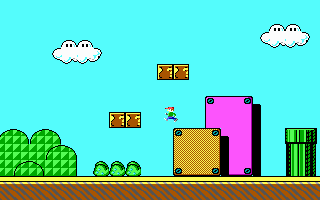
When John Romero walked into the office the next morning, he noticed a disk with the writing "Run me" written in Tom's handwriting on his desk. Having no idea what to expect, except for knowing that Carmack had been working on his side-scrolling engine lately, he booted up the disk.
- "As soon as the demo started running, I pressed the right arrow key to see if magic had indeed been made. As soon as little Dave walked a short way to the right...
- THE SCREEN SCROLLED.
- SMOOTHLY.
- Time stopped.
- I was speechless.
- There’s no way to overstate how completely and totally blown away I was. I couldn’t work for 3 hours, no joke. What I had in front of me was The Future.
- I had played so many games on the PC during my first year on the platform. I needed to know what I was up against as far as competition and see what the state of the art was in game programming. The VGA adapter was pretty new and not as widespread as the EGA adapter, which is what most PCs had at the time. And NO ONE had released a game with smooth horizontal scrolling like a Nintendo." — John Romero
Romero instantly realized the commercial value of this engine and because Softdisk would not allow games that did not also support CGA, he knew they would have to start their own company. So when Carmack and Hall arrived to the office, he closed the door and told them about his plan. Jay Wilbur also worked at Softdisk during this time and he happened to come by their office, so Romero decided to try taking him with them. At first Wilbur did not think Romero was serious, but after a little bit of convincing, Wilbur was in. So on September 20, 1990, id Software was unofficially born.
The search for a publisher
Porting Super Mario Bros. 3 to the PC
The first idea that the team came up with was to polish the demo they had made so that they could send it as a demo to Nintendo in order to propose a PC port of the title. And so they did. After some fast but necessary polish, Jay Wilbur sent it to Nintendo. According to rumors, the port demo made it to the highest levels of Nintendo and they were very impressed, but the idea of porting the game was declined because they envisioned the Mario series games as being exclusively for Nintendo's consoles.
The haunted fan letters
After being turned down by Nintendo, the guys continued working on their game in secret.
- "Softdisk didn't want to use the smooth scrolling trick Carmack had discovered (since it didn't also work in CGA), so we thought, well, if they don't want it, we could do something ourselves... So we thought, hey, we'll make our own game. We needed a topic. I asked if they cared what topic - sci-fi, fantasy, whatever. I think Carmack mentioned a kid that saves the galaxy or something. I went off and fifteen minutes later, came back with the paragraph that you see in Keen 1. I read it in a Walter Winchell voice (he's a nasal 40s radio/newsreel announcer). Carmack clapped after I was finished, and we were off and running." — Tom Hall
This is also when Romero noticed something odd about the so-called fan letters he had received, they had all the same address. Being furious about his discovery he wrote a letter known as the "psycho letter" back to Scott Miller. This is how the newly formed id Software made contact with Apogee Software.
Romero sent Catacomb to Scott Miller as a demonstration of their more current work, but when he saw the Super Mario Bros. 3 demo, he knew that any game using that engine had the potential to be a monster hit. Tom Hall, John Romero and John Carmack asked for $2,000 from Scott to finance their first project. Despite having only $5,000 dollars in his bank account at the time, he agreed and also apparently sent weekly pizza checks worth $100. The deal was finalized on September 28th, 1990 and the game was on.
Working on the first Commander Keen trilogy
The first episode
For the next three months, the guys were working at Softdisk and used pretty much every bit of their free time working on Commander Keen: Invasion of the Vorticons, with the following story as the starting point:
- "Billy Blaze, eight-year old genius, working diligently in his backyard clubhouse, has created an interstellar starship from old soup cans, rubber cement, and plastic tubing. While his folks are out on the town and the babysitter is asleep, Billy sneaks out to his backyard workshop, dons his BMX bike helmet, and transforms into...
- COMMANDER KEEN--defender of justice! In his ship, the Bean with Bacon MegaRocket, Keen dispenses justice with an iron hand!
- In this episode, aliens from the planet Vorticon VI find out about the eight year-old genius and plan his destruction. While Keen is out exploring the mountains of Mars, the Vorticons steal his ship and leave pieces of it around the galaxy! Can Keen recover all the pieces of his ship and repel the Vorticon invasion? Will he make it back before his parents get home? Stay tuned!"
The story they started out with is very close to the finalized story, with only small details changing like Keen using his brothers football helmet instead of his own BMX helmet. On December 14th, 1990, it finally happened, Keen 1 was released.
Finishing off the title
They still had two more episodes they had to finish in quite the haste and finish them in a haste they did.
Adrian Carmack, another employee of Softdisk was recruited as an artist to id Software during very late stages. The busy state the guys were in can be seen pretty well from this quote:
- "John Carmack asked me at Softdisk one day if I wanted to draw a few illustrations for a side project he was working on. He gave me his address, phone number, and directions. I'll never forget him saying "It's the house with the big satellite dish in the front yard." Every other house had a satellite dish in front. The address he gave me didn't exist and neither did the phone number! Ooooooooooo!!! I was steamin'!!!!!! I thought they were tricking me or something. Nope. He's just a genius who can't remember his phone number and address! I think he added his phone number and address together, took the square root dived by Pi, then Deltafraced the whole thing. That's where the confusion came in. He forgot to give me the formula. Anyway that's where the feud began!!!! MUUUUUHAHAHAHAAAAAA!!!" — Adrian Carmack
He ended up doing some of the graphical work on Keen 3, with the VortiNinja being one of the enemies he drew.
The level design of the last two episodes was also done in quite the haste, John Romero and Tom Hall designed about 16 levels levels in two days only which ended up hurting Keen 3 quite somewhat as there ended up being numerous bugs in the level designs, with one of the levels being impossible to complete because of this. This was later corrected with a patch.
Both Keen 2 and Keen 3 were finally completed on December 18th, 1990.
Post-release
Getting the first royalty check
The first royalty check arrived in January 1991 for about $10,000. Now it was final, the guys (John Romero, Tom Hall, Jay Wilbur, John Carmack and Adrian Carmack) were leaving Softdisk and id Software was officially formed on February 1st, 1991.
Updating the game
A few updates for the episodes were produced, but because a good method of patching games had not really been invented back then, these update ended up getting distributed only through ordering a new copy of the games. For a more specific list of changes made in the patches, see the respective pages for Keen 1, Keen 2 and Keen 3.
Publisher specific versions
Certain publisher specific versions of the game were also made. Currently, it is known that at least an exclusive version of the shareware episode was produced for Advanced Gravis Computer Technology for promotional purposes. Precision Software Applications (the distributor of the game in the United Kingdom) distributed a customized version of both the shareware and the registered versions.
Nintendo port
An advertisement sheet that Apogee Software was distributing shortly after the release of the first Commander Keen trilogy mentioned that a port of the game for the Nintendo video game console was under development and would soon be published by a major American Nintendo publishing company. No further information regarding the port was ever released and it was never heard of again.
Planned remake
A letter from August 1991 that was supplied to shareware vendors included the following advert for upcoming Apogee Software games:
- "Commander Keen II: Goodbye Galaxy — This game will break all records! There will be a 256-color VGA version, plus an EGA and a CGA version. All three versions will have multiple sound card support. This game will make the current Keen look like Pong—we have gone all out to make this the best game possible with many new innovations in graphics and animation. (Soon after the release off Goodbye Galaxy we will re-release the current Keen in CGA, EGA and 256-color VGA formats, with sound card support, too.)"
Whatever happened to the plan of re-releasing the original Commander Keen trilogy is not known. In fact, the vendor document seems to be the only place where this remake ever even got mentioned in, so it is quite safe to assume that there was never any real work done on the remakes. The scrapping of the VGA version of Goodbye, Galaxy! probably meant that there was little point in doing the remake and other projects, like Wolfenstein 3D, took over.
Removed features
Mysterious keycard
This mysterious item exists in the tileset of both Keen 1 and Keen 2, but it is never used in either of these episodes. What exact purpose the item was planned to have is unknown.
Story cutscene
There used to be a cutscene in the game which you could see when entering the story section from the main menu. In the cutscene one could see a Vorticon Guard approaching the Bean-with-Bacon Megarocket, stealing the parts you are supposed to recover in the episode, and then quickly disappear. Why this cutscene was removed can only be speculated upon, but the most likely reason is that in the end the cutscene was not all that exciting and having to watch it each time you entered the story section turned out to be a bore.
Gallery
Letter from John Romero, who sent levels converted into PCX to Scott Miller for marketing. Notice the blurb about getting Keen to run properly in Windows.
Letter from Electronic Arts. Scott Miller offered them to publish the Keen games, but after getting a submission form, decided that it's not worth it.
References
- id Software (1996). The Book of id. Mesquite, Texas.
- A Look Back at Commander Keen
- Dangerous Dave in “Copyright Infringement”
